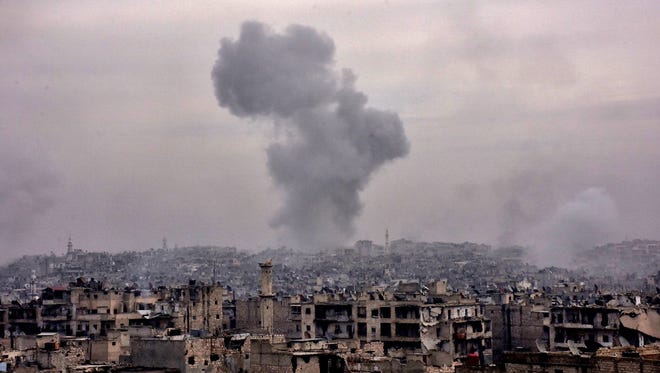Hellish conditions engulf east Aleppo, while life goes on in the west

All four hospitals in east Aleppo are shuttered, so physician Mohammed Kaheel can’t care for Syrians injured from unrelenting bombardments and chemical weapon burns. There's no anesthesia, antibiotics or bandages.
“People are fleeing from one neighborhood to another," seeking treatment and shelter, he said in a phone interview as bomb blasts from Syrian government and Russia jets pounding the rebel stronghold exploded in the background. "We lack everything: medications, food, water and fuel.”
A few miles from the hellish conditions in east Aleppo lies another world. Most residents of west Aleppo have remained loyal to the regime of President Bashar Assad, and life goes on normally even as Syria's long and bloody civil war rages around them. People can shop at markets, go to work and walk to school.
“The situation here in west Aleppo has been the same for 4½ years,” gastroenterologist Nabil Antaki said. He heard that people were suffering in east Aleppo but hadn’t ventured there to see for himself.
If he had, he would see an ancient city reduced to rubble. He would see thousands of people trapped without adequate food, water or medicine, no electricity, no hospitals or schools and death constantly lurking nearby, as Syrian forces, aided by Russian airstrikes, move ever closer to retake east Aleppo by bombing everything from apartments to humanitarian aid convoys.
The rebel stronghold has been surrounded and under siege by government forces since the summer, and Assad is on the brink of regaining full control of what once had been Syria's largest city and commercial capital. Government troops have seized three-quarters of the rebel positions amid vicious fighting and bombing that have forced hundreds of thousands to flee a metropolis that had a population of 2.5 million before war broke out in 2011.
East Aleppo has long been distinct in character from its western counterpart. The neighborhoods include historic districts with narrow alleyways dating to the 12th century and communities of devout Sunni Muslims with large families who moved into the city from the countryside.
Professionals and the more secular, educated upper-middle classes have long lived in the city’s newer and more modern western neighborhoods along with Christians and members of Assad's Alawite sect.

Since the rebels took over the east in 2012, the differences have become even more stark.
“With the presence of militants, it is impossible not to wear a head scarf in the eastern part,” historian Souheil Lawand said of Islamic State fighters who are among the anti-government groups entrenched there. “It is normal not to wear one in the western part.”
The pro-Assad residents of west Aleppo can shop in markets where items are available but increasingly expensive because of the war and can even take a quick weekend holiday in Beirut, a four-hour drive.
“The road to Lebanon was opened by our troops about two months ago, and, without wanting to be too optimistic, the news from the front lines is good,” Antaki said.
The war sometimes spills over into the west, such as when a rebel bombardment recently hit a few neighborhoods. The main impact is intermittent electricity and costlier goods.
“We now depend mostly on local generators,” said Ibrahim Abd Al Majid, 34, a civil servant who lives in the Hammadiyya neighborhood of west Aleppo.

Al Majid said his daughters continue to go to school, and his wife knows where to find fresh vegetables and meat for family meals. "Food is available but very pricey, drinking water has to be bought, and washing water is supplied by tankers who truck it in since the treatment plant on the rebel-held side cut off the supply,” he said.
In eastern Aleppo, all the hospitals are destroyed, while the western side has 11 of 12 functioning, World Health Organization spokesperson Fadéla Chai said.
Most of the bakeries in eastern Aleppo have been bombed, and even those that have flour don't have fuel for ovens. People use doors for firewood, as temperatures drop below freezing at night.
“Most of the buildings are without doors and windows,” physician Kaheel said. “There are little kids dying from exposure. What should I describe to you? The hunger? The cold? The pain of the injured?”
Abu Nihad, who works with the White Helmets, a volunteer group in east Aleppo that provides emergency services, said the suffering is worse than ever. “I do not know where to start to describe it,” Nihad said. "This is a savage assault by the regime.”
The Syrian military recently dropped leaflets over east Aleppo urging the rebels and their supporters to evacuate the city: "This is your last chance — rescue yourselves. If you do not evacuate these districts soon, you will be destroyed. We have left a safe path for you to leave."
Thousands have heeded that warning by fleeing to the west, but others refuse to leave for fear they will be killed by Assad's army.
“We have no choice," Kaheel said. "Would we go back to those who destroy, kill and bombard us?”
Wirtschafter reported from Cairo and Nabeel from Istanbul.